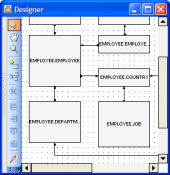Oracle Maestro online help
| Prev | Return to chapter overview | Next |
Editing cluster properties
Cluster Editor provides you with an ability to edit cluster properties in the easiest way.
Every Subitems tab is intended for managing cluster fields, tables, indexes. Each object can be opened in its editor. Use grid’s popup menu to create new, edit or drop the selected cluster subitems. Using the popup menu you can also copy the selected objects to clipboard or paste previously copied objects. You can operate on several objects at a time. For this you have to select view objects with the Shift or the Ctrl key pressed. After a group of objects is selected you can operate on it, e.g. delete several objects at once, as if it were a single object.
Name
Here you can view and change the cluster name.
Owner
The field displays the owner of the cluster.
Created
The field displays the date the object was created.
Last DDL time
Use the field to find the date when the last data definition language (DDL) operation was performed on the current object. The Last DDL time can help you to find if any changes to the object definitions have been made on or after a specific time.
Storage options
Here you can find the tablespace in which the cluster is physically located.
Cluster type (Default, Index, Hash)
Specify Index to create an indexed cluster. In an indexed cluster, Oracle Database stores together rows having the same cluster key value. Each distinct cluster key value is stored only once in each data block, regardless of the number of tables and rows in which it occurs. In a Hash cluster, Oracle Database stores together rows that have the same hash key value.
Key size
Specify the number of hash values for the hash cluster.The hash value for a row is the value returned by the hash function of the cluster. Oracle Database rounds up the keys value to the nearest prime number to obtain the actual number of hash values. The minimum value for this parameter is 2. If you omit both the INDEX clause and the keys parameter, the database creates an indexed cluster by default.
 Row dependencies
Row dependencies
Specify the option if you want to enable row-level dependency tracking. This setting is useful primarily to allow for parallel propagation in replication environments. It increases the size of each row by 6 bytes.
 Has cache
Has cache
Check the option if you want the blocks retrieved for this cluster to be placed at the most recently used end of the least recently used (LRU) list in the buffer cache when a full table scan is performed. This clause is useful for small lookup tables.
You can also set Parallel properties and view some statistic options in Miscellaneous tab.
To apply the changes, select the Apply Changes item in the Navigation bar or use Ctrl+F9 or Ctrl+F7 shortcut keys.
It is also possible to modify object properties without opening the object editor: use the Object Properties item of the popup menu of the selected object from the explorer tree.
| Prev | Return to chapter overview | Next |





 Download
Download Buy
Buy
